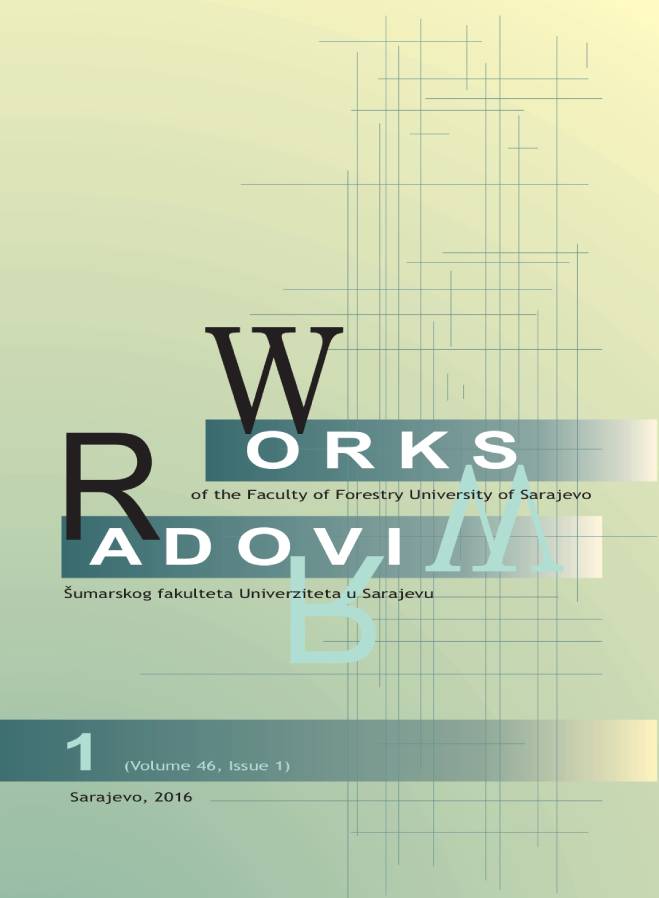ANALYSIS OF THE FOREST FIRES IN THE KONJIC MUNICIPALITY IN THE PERIOD OF 2009 - 2013 YEAR
DOI:
https://doi.org/10.54652/rsf.2016.v46.i1.78Keywords:
forest fires, municipality Konjic, 2009 – 2013 yearAbstract
UDK: 630*43(497.6 Konjic)“2009/2013“
Forests as one of the largest renewable sources in nature, are extremely important for human survival. They cover about a quarter of the Earth's surface and are the lungs of all living beings. Rapid technological development has significantly improved the life of a man, but also made a great contribution to the destruction of the natural balance, and reducing biodiversity.
They represent a significant social wealth not only by producing precious and for its quality values in many ways irreplaceable wood material, edible and medicinal plants, but also because its existence is a very positive impact on the protection and improvement of the environment, regulation of climate and water regime, reducing damage from erosion, flood and spate, development of recreation, tourism, hunting and many other economic activities. Fires are one of the strongest and most dangerous agents that man were served in suppressing forest since ancient times, but unfortunately still used today. In many parts of world man suppresses forest and brush with fires, creating a short-term favorable conditions for its economy.
Research that are the subject of this paper is an analysis of the volume of forest fires in the period 2009-2013 year in the municipality of Konjic. The conducted analysis in this area in the period 2009-2013 year recorded 37 fires. Of that number, 20 fires were in the category of crown-fires and 17 ground-fires. The largest number of fires was 14 in 2011, with 310 hectares of fire-affected areas, while the lowest number was recorded in 2010, only three fires and burnt area amounted to 7 ha.
Downloads
References
DIMITROV, T. (1994): Biološki parametri prikladni za poboljšanje indeksa opasnosti od šumskih požara. Šumarski list, str. 105-111. Zagreb.
DIMITROV, T. (2000): Budući požari u odnosu na globalno zatopljenje. Šumarski list, br. 3-4., str. 203-209. Zagreb.
DUCIĆ, V., MILENKOVIĆ, M., RADOVANOVIĆ, M. (2007): Geografski faktori nastanka šumskih požara u Deliblatskoj Peščari, zbornik radova, Beograd.
FLOLLIOTT, P.F. (1988): Opportunites for Fire Menagment in the Future. Proceedings of the Symposium Effects of Fire Menagment of Southwestern Natural Resources, General Tehnikal Report, RM-191, Rocky Montain Forest and range Experiment Station, Fort Collins, Colorado, str.152.
GLAVAŠ, M. (2003): Šumski požari i protupožarna zaštita na području uprave šuma podružnice Senj od 1994-2003. godine, Šumarski list, 79-91, Zagreb.
GLAVAŠ, M. (2005): Šumski požari u Republici Hrvatskoj, rad u pripremi - Šumarski fakultet Zagreb.
JURJEVIĆ, P., TOLIĆ, I. (2004): „Šumske prosjeke nisu zapreka za požare“, Hrvatsko šumarsko društvo, Šumarski list 1 -2; str. 55-61.
JURJEVIĆ, P., VULETIĆ, D., GRAČAN, J. (2009): „Šumski požari u Republici Hrvatskoj“, Hrvatsko šumarsko društvo, Šumarski list 1-2; str. 63-72.
KÜHRT, E., KNOLLENBERG, J., MERTENS, V. (2001): An automatic early warning system for forest fires, Annals of Burns and Fire Disasters - vol.XIV - n. 3 - September 2001.
MAMUT M. (2011): Veza prirodnogeografske i sociogeografske osnove Dalmacije s ugroženošću otvorenog prostora požarom, Šumarski list, 1-2, CXXXV, 37-50, Zagreb.
MARGALETIĆ, J., MARGALETIĆ, M. (2003): Požari u šumi i na šumskom zemljištu kao čimbenici degradacije staništa, Zagreb.
MLADINEO, N., KNEZIĆ, S., BUZOLIĆ, J. (2001): Protupožarna zaštita korištenjem GIS podrške i protupožarnih senzora. Vatrozaštita,protuprovala i videonadzor, Zbornik radova, Šibenik, 1–8.
NETOLICKI, A., BLAŽEVIĆ, T., ANTOLOVIĆ, A. (2012): Višekriterijska analiza rizika od požara u Splitsko-dalmatinskoj županiji, Kig br.17, Vol. 1.
NIKOLOV, N. (2006): „Report on fires in the Balkan Region“; FAO Forestry Department, Rome, Italy; str. 1-24.
NODILO, J. (2003): Požari otvorenog prostora otoka i priobalja – slučajnost ili logičan slijed događaja?, Šum. list, (3-4), 171-176, Zagreb.
PYNE, J., PATRICIA, L., ANDREW D.L., RICHARD, D. L. (1996): Introduction to Wildland Fire, second edition, John Wiley & Sons, Inc. New York.
ROSAVEC, R., DOMINIKO, D., BARČIĆ, D.,STAREŠNIĆ, D., ŠPANJOL, Ž., BILJAKOVIĆ, K., OŽURA, M., MARKOVIĆ, N., BOGNOLO, D. (2009): Analiza raspodjele površina zahvaćenih šumskim požarom na otocima Braču, Korčuli i Rabu , Šumarski list br. 5-6, CXXXIII (2009), str. 301-307, Zagreb.
ŠPANJOL, Ž., ROSAVEC, R., BARČIĆ, D., GALIĆ, I. (2011): Zapaljivost i gorivost sastojina alepskog bora (Pinus halepensis Mill.), Croat. j. for. eng. 32 (2011), str. 121-129, Zagreb.
USČUPLIĆ, M. (2001): Šumski požari u Bosni i Hercegovini i evaulacija šteta. Radovi Šumarskog fakulteta u Sarajevu. No 1, 2001. (7-17) Sarajevo.
VESELINOVIĆ, M., MILENKOVIĆ, S. (2007): Prevencija šumskih požara, Priručnik za edukaciju trenera, Institut za šumarstvo, Beograd.
VULETA, E. (2001): Šumski požari u Republici Hrvatskoj u razdoblju od 1996. do 2000. godine. Diplomski rad. Šumarski fakultet Sveučilišta u Zagrebu, 1-35.
WHELAN, R. J. (1995): The Ecology of Fire. – Cambridge University Press.






















